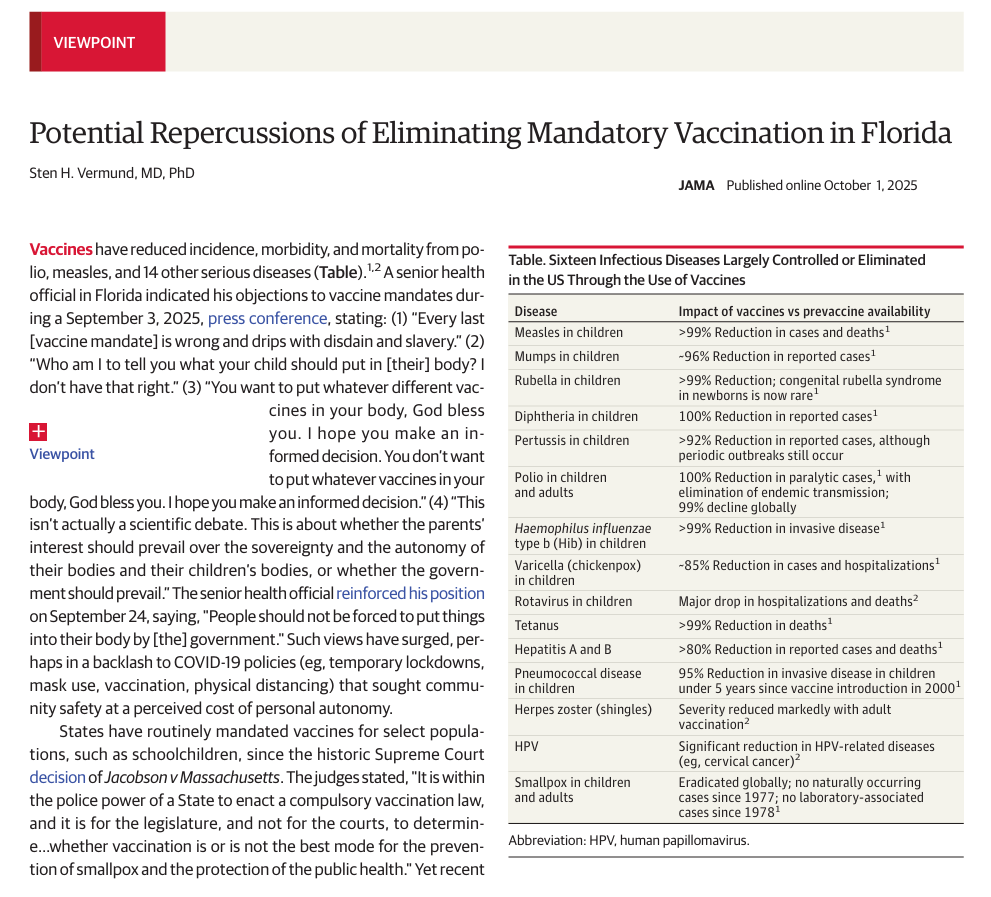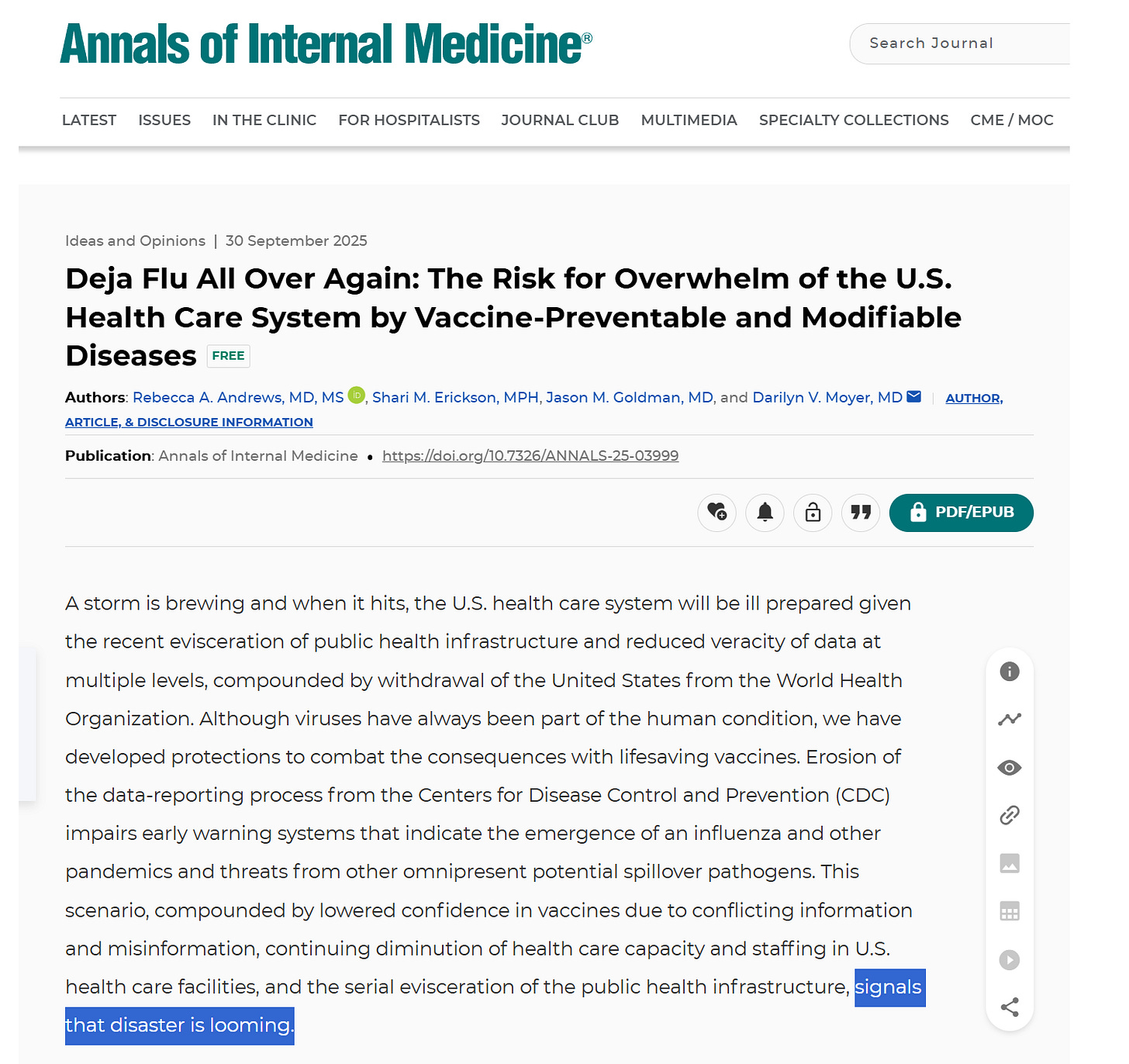Bio-Pharmaceutical Complex Launches Fear-Mongering Manuscripts on Return of Vaccine-Preventable Diseases
Dropping Childhood Vaccination, CDC Budget Cuts Has Gotten Attention of Academia
By Peter A. McCullough, MD, MPH
In our New York Times best-selling book Vaccines: Mythology, Ideology, and Reality we disclose the amazing impact of sanitation, nutrition, and hygiene that resulted in >90% reductions in vaccine-preventable, serious illness BEFORE vaccines were introduced to the population. So if better living standards did the job, why would diseases like pertussis come roaring back if vaccines were dropped?
Dr. Sten Vermund who served as Chief of the Vaccine Trials and Epidemiology Branch at the National Institute of Allergy and Infectious Diseases (NIAID) and has recent grants have included projects funded by USAID is a vaccine promoter at Department of Global, Environmental, and Genomic Health Sciences, College of Public Health, University of South Florida. He is not someone who have give an unbiased opinion regarding the clinical need for vaccines nor a risk-benefit analysis. He published a viewpoint in JAMA recently making the case for vaccine mandates:

As expected, Florida has experienced a resurgence of vaccine-preventable diseases. In 2024, a measles outbreak at an elementary school in south Florida contributed to 12 confirmed measles cases statewide. This resurgence continued into 2025, with at least 12 measles cases (through August) in 4 counties in south, central, and northern Florida, including elementary and high schools. The Florida outbreaks were not unique. From January to August 2025, the Texas Department of State Health Services (DSHS) reported 762 confirmed cases (718 in unvaccinated (or vaccine status unknown) and 44 in vaccinated persons), 99 hospitalizations, and 2 deaths (not adjudicated) among unvaccinated school-aged children. The outbreak spread across 37 Texas counties, with linked cases reported in Arizona, Colorado, Georgia, Illinois, Iowa, Kansas, Missouri, New Mexico, Oklahoma, Utah, Canada, and Mexico. Cases occurred overwhelmingly in communities with low overall vaccination coverage.4 The Texas DSHS reported $4.5 million in direct public spending. Based on a 2019 measles outbreak in Clark County, Washington, health economists estimated an aggregate cost of $47 479 per measles case.5 Thus, the 762 Texas cases may accrue total costs of more than $36 million. The costs of health care alone for, say, 600 Florida measles cases might engender costs near $30 million, but case numbers may go much higher if circulation in schoolchildren resumes at high rates, and deaths may ensue.6,7 The state of Florida may have even more to lose economically, in the billions of dollars, from measles transmission given the potential economic harm to its vast tourism industry.
If hospitalizations and deaths are avoidable with early treatment, which Vermund does not mention, and have not been adjudicated due to invasive measles, then do any of his arguments hold water? For a healthy child appropriately managed, if measles means 5 days home from school, how can that cost $47,479?
Andrews and colleagues go further and predict our health system will be “overwhelmed” with “disaster looming” after withdrawal from the WHO and trimming our public health agencies resulting in lower vaccination rates for COVID-19, respiratory syncytial virus, and influenza.

A storm is brewing and when it hits, the U.S. health care system will be ill prepared given the recent evisceration of public health infrastructure and reduced veracity of data at multiple levels, compounded by withdrawal of the United States from the World Health Organization. Although viruses have always been part of the human condition, we have developed protections to combat the consequences with lifesaving vaccines. Erosion of the data-reporting process from the Centers for Disease Control and Prevention (CDC) impairs early warning systems that indicate the emergence of an influenza and other pandemics and threats from other omnipresent potential spillover pathogens. This scenario, compounded by lowered confidence in vaccines due to conflicting information and misinformation, continuing diminution of health care capacity and staffing in U.S. health care facilities, and the serial evisceration of the public health infrastructure, signals that disaster is looming. Simultaneously, we have seen reduced funding and cessation of federally supported public health efforts. Approximately one quarter of the CDC workforce has been eliminated on the heels of the highest level of influenza-related illness in the 28 years that CDC has monitored influenza activity.
Considering that CDC has >12,000 employees and >$9 billion dollar budget and does not operate a single clinic or hospital or deliver care for even one patient, how can a budget cut result in a “disaster”?
In my view manuscripts such as these represent academic fear-mongering. They misrepresent the facts to conjure up anxiety among their physician readers, who in turn, transfect fear in the exam room to the patient. Because these claims are so exaggerated and easily exposed, hopefully the public will see these as fear-based marketing for more vaccination instead of evidence-based clinical concerns.
Please subscribe to FOCAL POINTS as a paying ($5 monthly) or founder member so we can continue to bring you the truth.
Peter A. McCullough, MD, MPH
FOCAL POINTS has partnered with Patriot Mobile to defend your medical freedom. Join Patriot Mobile today!




These “warnings” sound like they are right out of the Vaccine promoters playbook. The same things were said about Leicester, England back in 1890 when the city council voted to eliminate vaccine mandate for small pox. Not only did the “outbreak” NOT occur over the next 40 years, but citizens enjoyed a lower death rate from and occurrence rate of small pox compared to “vaccinated” communities elsewhere.
Interesting officials report “picking up” a signal for increased infections but totally missed signals for the harms of Covid vaccine.
More evidence that our academic journals have been purloined by the pharmaceutical industry. If this were an honest article, they would address the weaknesses in their argument and advocate for more research, just as any responsible researcher does in a more unbiased article.